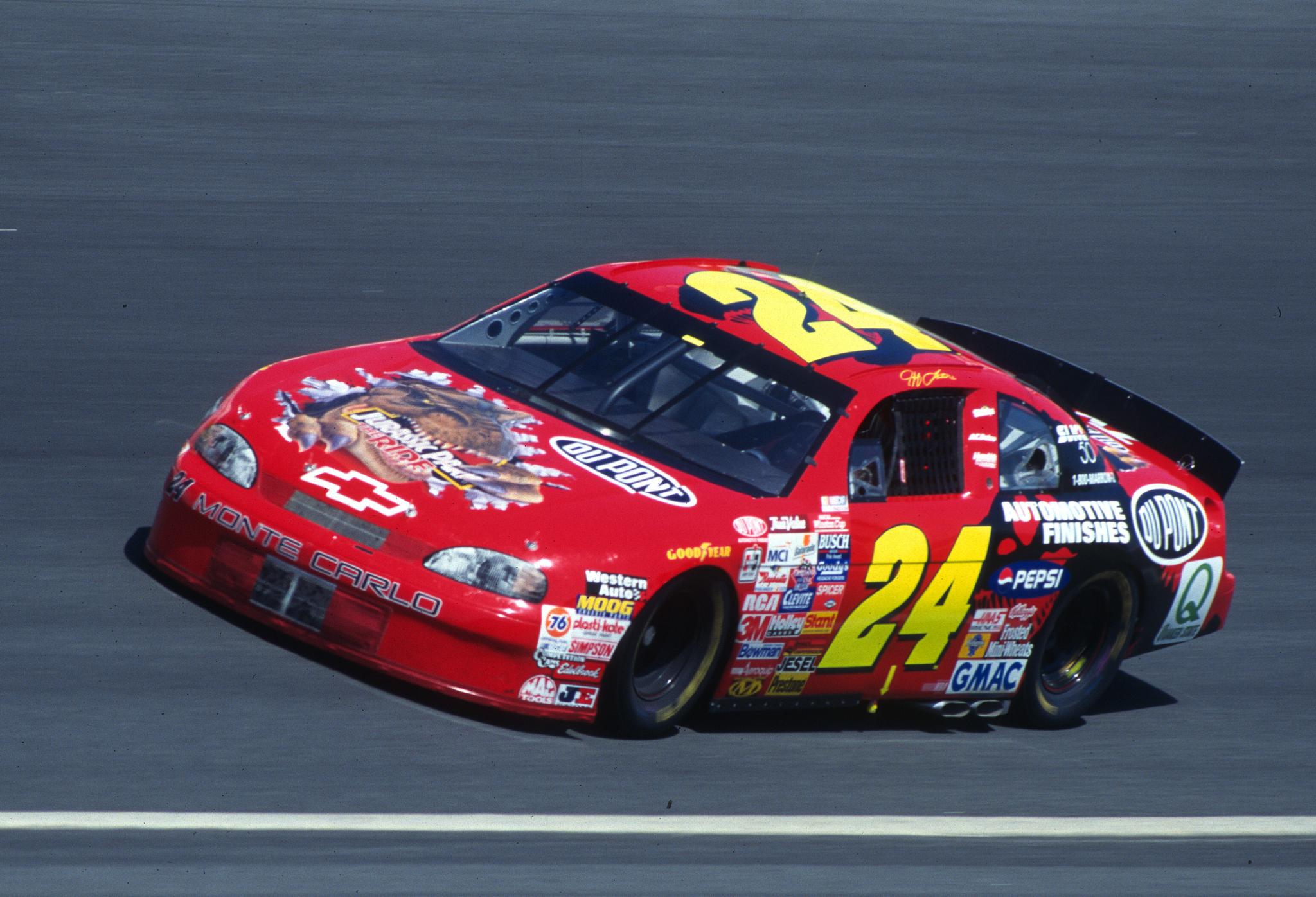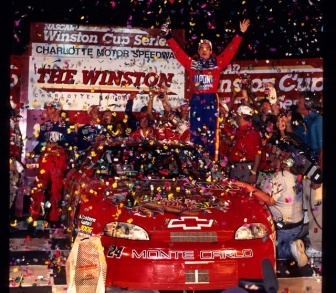All Star Moments: 1997 – “T-Rex”
 |
| Jeff Gordon celebrates in Victory Lane with "T-Rex" |
| Charlotte Motor Speedway |
Among the unique aspects of the NASCAR All Star Race is the fact that there is no points on the line, there's no other goal other than a huge payday for the winner at the end of the race.
By its very nature as a non-points event, the all-star race allows teams a golden opportunity to test out new ideas without putting their whole season on the line. With nothing to lose, teams sometimes roll into the all-star race with a new chassis setup, or a new engine package, sometimes even a new driver.
In short, the All Star Race is the perfect testing session. Nothing to lose, everything to gain.
And for that reason, some teams will occasionally go for the Hail Mary play – bringing something to the table that, if it works, could change everything.
On May 17, 1997, Jeff Gordon crossed the line ahead of his Hendrick Motorsports teammate Terry Labonte to win the 13th running of the All Star Race for his second win in the event.
The fact that Gordon won the race wasn't what made the race memorable – it was the car Gordon drove to victory that night that got everyone's attention. It was a car designed from the ground up to be unlike any other racecar. A car design so well engineered that its very presence at the race caused a panic among other competitors and ultimately led to it being outlawed.
It was a car known as "T-Rex".
"T-Rex" was an R&D creation built by Hendrick Motorsports, a "test bed" for just about every idea that engineers at HMS could dream up that they've ever wanted to put in a racecar.
[adinserter name="GOOGLE AD"] It was, in fact, a car built to push the limits of the NASCAR rulebook by taking advantage of every loophole and gray area the team could find. It was a car that tiptoed the line between "in compliance with the rules" and "illegal as hell".
And what better race to try it out than the All Star Race? And what team better to try to push the envelope than Hendrick Motorsports?
Since coming into the sport as a team owner in 1984, Rick Hendrick had been known as an innovator. Hendrick helped pioneer the concept of the multi-car team in the early 90's, and was one of the first teams to employ and train full-time pit crews.
Hendrick was also good at spotting raw talent, which is why he plucked a young 21-year-old driver Busch Series driver from California named Jeff Gordon to drive for him in 1992 and brought along his crew chief, Ray Evernham.
Evernham was a think-outside-the-box kind of crew chief. A former modified racer, Evernham has spent some time in the trenches working for Alan Kulwicki before partnering up with Gordon while Gordon was still in the NASCAR Busch Series. The two forged a relationship that paid off with 47 Cup victories and three championships over a six-year period.
But back in 1997, Evernham wanted to try to spread Hendrick Motorsports' wings to their fullest extent, and set out to design a racecar unlike any other. With Rick Hendrick's endorsement, he approached team engineer Rex Stump and commissioned him to help design a car. The idea was simple – throw out everything you know about a conventional racecar and build it from the ground up. A design that exploited every loophole or gray area in the rule book, but was still perfectly legal under NASCAR's rules. A perfectly engineered car.
The car was known as Hendrick Motorsports Chassis No. 2429, but after signing a deal with Universal Studios to promote their new attraction "Jurassic Park: The Ride" with a special paint scheme, the car got a new nickname: "T-Rex".
After a shake-down test at Texas Motor Speedway, T-Rex made its debut at the All Star Race, and it was apparent as soon as the car rolled onto the track that every crew chief on every team had their eye on the car.
 |
| Gordon hits the track in "T-Rex" |
| Charlotte Motor Speedway |
In qualifying, Gordon had slid through his pit box and wound up 19th, so team wouldn't get to see what T-rex could do until Saturday night.
Once the race started, Gordon quickly made his way to the front of the field and finished the first segment in third, then after the field was inverted, fought his way back to finish the second segment in fourth.
But the best was yet to come.
Barely on lap into the final 10-lap segment, Gordon shot past his teammate Terry Labonte to take the lead and easily cruised to the finish for his second All Star Race victory.
But after all the high-fives and trophy pictures and the presentation of the $300,000 winner's check, NASCAR inspectors pulled Evernham aside.
"Don't bring this car back next week," they told him.
T-Rex's revolutionary design elements not only impressed the team, they impressed all their competitors as well, who loudly complained to NASCAR that Hendrick's engineering marvel would make dinosaurs out of their own race fleets.
The following week, NASCAR officials paid a visit to the Hendrick Motorsports shops near Charlotte Motor Speedway and gave T-Rex a thorough looking-over. Within a matter of weeks, the reulebook was re-written to close all the loopholes and fill in all the gray areas, and T-Rex, like its namesake, was extinct.
 |
| "T-Rex" now sits silently in the Hendrick Motorsports Museum |
Although the car in its whole form was illegal, T-Rex's legacy lived on – many of the innovations the team came up with that were still legal were applied to all the cars in Hendrick's fleet, and Gordon and Evernham went onto win the next two Winston Cup titles.
The car itself was revived as well, albeit stripped of its many now-illegal additions, running in the 1997 Brickyard 400 at Indianapolis Motor Speedway. Gordon qualified 24th and finished fourth behind race winner Ricky Rudd.
The now-retired car, re-painted in its famous Jurassic Park livery, is currently on display at the Hendrick Motorsports shop. An unassuming place for a car that nearly changed it all.
Special thanks to Jonathan Coleman and the PR Staff at Charlotte Motor Speedway, and to Brandon Reed for their contributions to this article.
[adinserter name="GOOGLE AD"]
